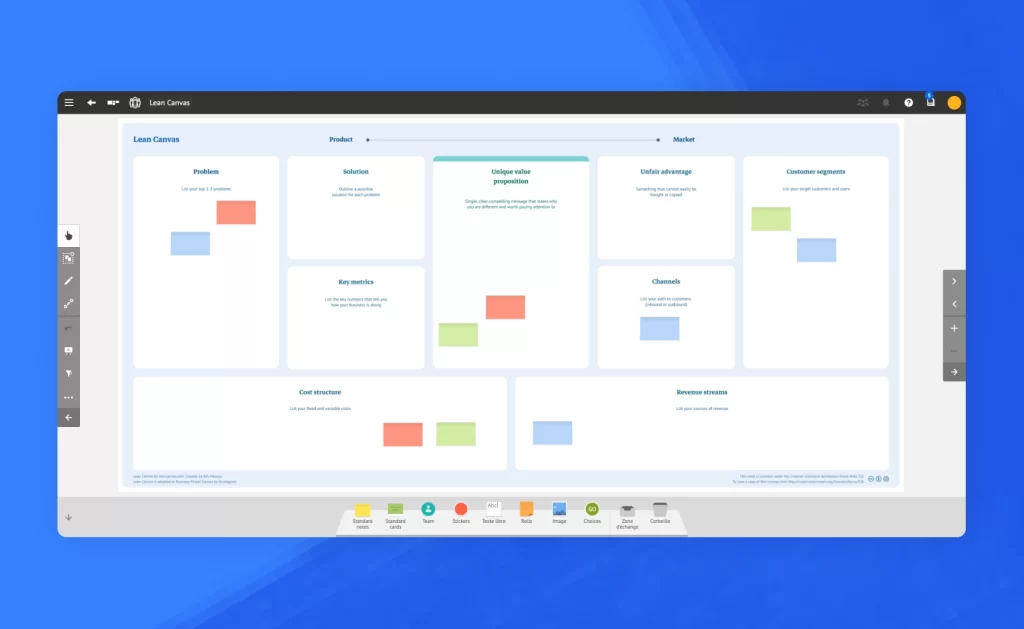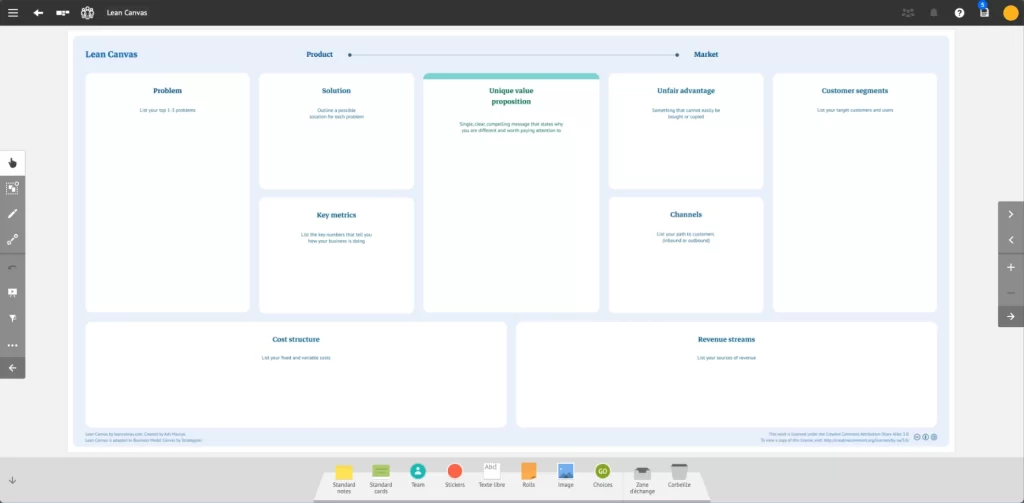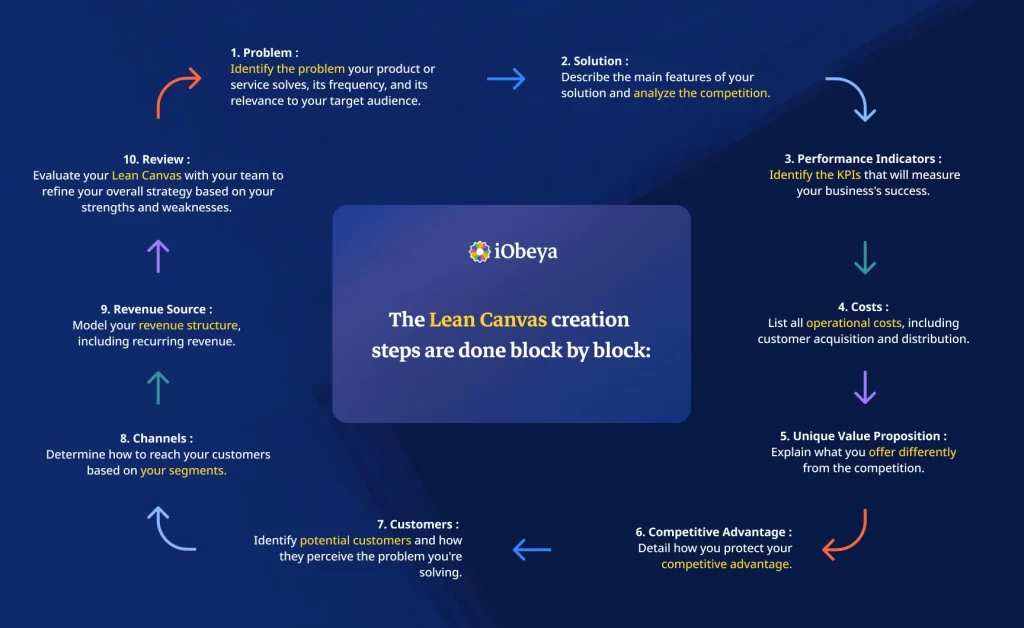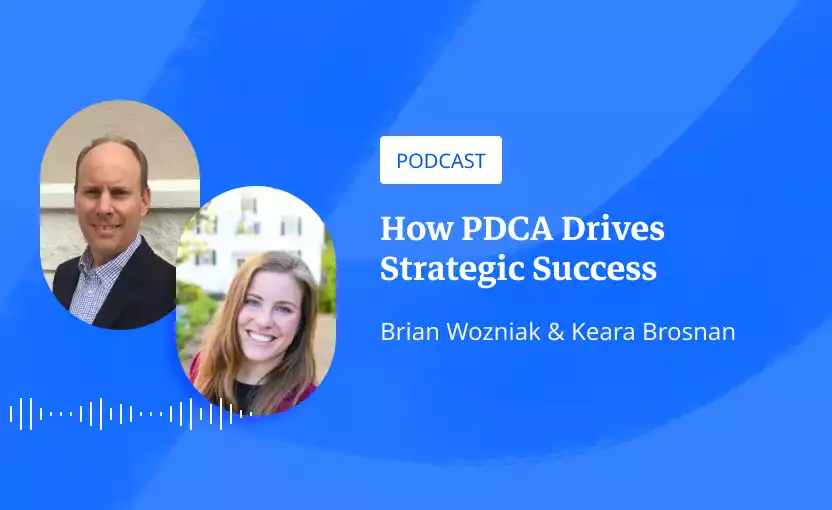What is a Lean Canvas
Hey, let’s start your
iObeya journey!
The Lean Canvas is a one-page business plan model created in 2010 by Ash Maurya, an American entrepreneur, to simplify and streamline the evaluation of business opportunities. It provides a more concise alternative to the Business Model Canvas , allowing teams to break down their ideas into assumptions, thus avoiding lengthy and tedious business plans.

Key Data to Compile in a Lean Canvas
The Lean Canvas sets itself apart from the Business Model Canvas by replacing four sections:
- “Partners” with “Problems”
- “Key Activities” with “Solutions”
- “Key Resources” with “Indicators”
- “Customer Relationships” with “Competitive Advantages”
Let’s go through the various key data points to fill in your Lean Canvas.
1. Customer Segments
This section aims to clearly define your customer segments. It’s essential to distinguish between customers (those who pay) and users (those who use the product or service). Additionally, it is important to identify your “early adopters” – key players who are at the forefront of new trends, products, and technologies. Their influential status as innovators and trend setters can amplify your presence in social networks and spread within their network.
2. Problems
Understand what affects your customers in -depth, their “pain points,” and frustrations. Identify three major problems you want to solve. Each problem must be deeply important to the customer, captivating their interest through your value proposition. For each identified problem, analyze the obstacles faced by the customer (costs, resources, etc.), the aspects causing them difficulty, their concerns (financial, social, technical risks), and the undesirable situations they might encounter. Also, explore alternative solutions (noted in the lower part of the section) and specify how these problems are currently being resolved.
3. Value Proposition
The value proposition represents the benefits customers can expect from your product or service, addressing a need that is poorly or unsatisfactorily met. Be concise, clear, and compelling in your customer promise. Your message should be relevant enough to transform a casual visitor into an interested prospect.
4. Solutions
Not to be confused with the value proposition, here you should identify three essential solutions (features, products, or services) that will help you create your value proposition by providing a solution to each identified problem. Be pragmatic and practical in your customer-oriented approach.
5. Channels
This section encompasses all the means of communication and distribution you use to reach your ideal customers, both online and offline. It’s about how your offering reaches the customer, but it’s also an opportunity to set yourself apart. Separate your channels into two categories: “Inbound” (attracting prospective customers through content such as videos, blogs, social media, webinars, podcasts, whitepapers, etc.) and “Outbound” (marketing actions, promotions, advertising, such as email/SMS campaigns, AdWords, social media ads, sponsorship, landing pages, traditional media, etc.).
6. Revenue
This section encompasses all revenue sources generated by your business. Identify whether these revenue streams will be: one-time or recurring; fixed (catalog prices, packages, subscriptions, rentals, advertising, etc.) or variable based on conditions (real-time, auctions, customized, etc.). Additionally indentify how and when customers will pay (before or after you pay your suppliers) and detail the different pricing strategies based on your customer segments.
7. Costs
Evaluate all the costs necessary for the proper functioning of your business. Identify variable costs, which depend on the level of activity and increase with revenue, and fixed costs, which are independent of revenue.
8. Key Performance Indicators (KPIs)
Measuring key performance indicators (KPIs) is essential for improvement. Define quantitative goals to assess the relevance of your value proposition (through surveys, live chat, reviews, calls, etc.) and to measure the overall success of your business (number of downloads, customer satisfaction, revenue over a given period, etc.).
9. Competitive Advantage
Identify what sets you apart from the competition. This competitive advantage should be difficult for competitors to copy, such as an existing community, a qualified network, loyal customers, significant recognition, a talented team, unique expertise, exceptional customer experience, etc.
What Are the Advantages of Lean Canvas?
Using Lean Canvas offers several advantages:
- Simplicity: Unlike other business analysis tools, Lean Canvas is simple and affordable. The crucial element is to involve all stakeholders in your business to contribute to each aspect of the canvas.
- Overview: It’s easy to get lost in the daily details of business management, losing sight of objectives and the big picture. Lean Canvas helps you stay focused on the overall strategy and identify threats and opportunities.
- Internal and External Factors: Lean Canvas explores not only your company’s internal strengths but also potential external threats and factors that could influence profitability. You can then adjust your internal processes accordingly.
When Should You Use the Lean Canvas Technique?
Lean Canvas is recommended in various situations, especially when you want to develop a new business idea, product, or service. Here are some instances when it’s appropriate to use Lean Canvas:
- Startup Launch: If you are an entrepreneur or working on a startup idea, Lean Canvas can help you structure your concept, identify opportunities, and minimize risks by quickly testing key assumptions.
- Development of a New Product or Service: Before launching a new product or service, Lean Canvas allows you to clearly define the problem you’re solving, articulate your unique value proposition, and design a solid business model.
- Strategic Repositioning: Lean Canvas can be used to explore new opportunities or review an existing business model, helping to adapt to market changes.
- Agile Planning: Lean Canvas is highly recommended for businesses adopting the Agile method, as it encourages quick iteration and adjustment of the strategy based on market feedback.
- Market Research: Lean Canvas can serve as a starting point for market research. By answering questions about your target audience, value proposition, and distribution channels, you gain a better understanding of your business’s viability in a given environment.
- Investor Presentation: The conciseness of Lean Canvas makes it easy for investors to quickly understand a business concept, value proposition, and business model. This synthesis is appreciated by investors.
In summary, Lean Canvas is a versatile tool that can be used at various stages of business development to structure ideas, validate concepts, plan strategies, and adapt to market changes. It is particularly effective for businesses looking to control expenses and optimize their processes in Agile mode.
How to Create a Lean Canvas on iObeya?
Creating a Lean Canvas on iObeya is done from the board background catalog. Insert a Whiteboard, then select the board background and choose the “Lean Canvas” board.
The Lean Canvas board background consists of a series of sections, with each section designed to help you articulate your responses in a simple and direct manner. You can include cards and links on the board as needed. Collaboration is easy, as you can share your board with other team members and people with access to your digital Obeya .

The Lean Canvas creation steps are done block by block:

The Lean Canvas is a valuable tool for strategic planning, helping businesses stay agile, reduce risks, and improve their chances of success. Feel free to use it!







